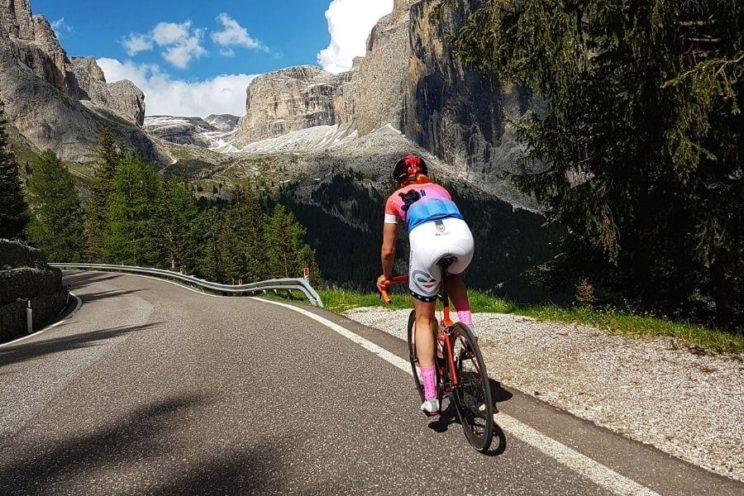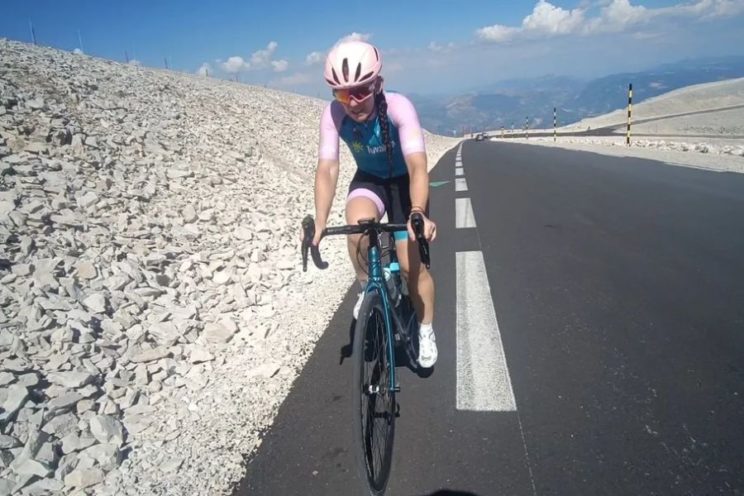In
this article We already explained some tricks to successfully overcome mountain ports, both in up and down. But we want to deepen more in the aspect of climbing, this time to climb long -distance bike ports.
That you always suffer in a long and laid climb does not have to worry too much. It is something that every cyclist has to assume. In the ports they all suffer, whether the best climber in the platoon or the most corpulent sprinter. On the climb, extra energy is suffered, because we have to advance with the bicycle having the severity of the slope.
However, the best or worse work on factors such as training, weight control, pedaling technique or the management and reserve of forces end up making the difference between cyclists and others.
To be a resistant climber and crown the longest and longest ports without too many problems, you must improve all these facets, paying special attention to the last one: adequately manage your strength.
What do we call long distance ports?

For an occasional or amateur cyclist, a port can be very long if it has 4 or 5 kilometers. However, for someone who competes that same distance, a small level can be considered and will overcome it without too many problems.
If we talk about cycling outside the competition, a long-distance port would have to have 8 km or more to moderate slope (5-7%). If we take into account the average speed and ascension time used to crown it, between 45 minutes and an hour pedaling on the bicycle. They are increases that demand a great physical background or resistance. Therefore, they have to face them with a different tactic from the rest.
Tricks to upload a long port better
A very practical method to successfully crown a large mountain port is to divide the ascent by parts or zones. This will allow you to better manage your energy tank, arriving with reservations to the last kilometers. Mentally fragment the ascension will allow you to find the most efficient rhythm of climbing more easily. That is, with which you advance more consuming less energy.
A good trick is to consider the rise in four parts, rolling from less to more
You can divide the port into four parts: approach, base, intermediate zone and final zone or top. In each of them you must manage your forces in a different way.
Approach terrain
They are the kilometers prior to the beginning of the ascent, plains or with a slight slope. Here we recommend taking a living rhythm, but not too strong or explosive. The intention is that you reach the first ramps with sufficient inertia to adapt the development and your pedaling to the slope without suddenly stuck.
Port base
In an 8 km port it would be the first two, approximately. It is a key moment of ascension. You have arrived strongly at the first slopes and horseshoe curves, but you should not trust. It acts intelligently and reserves that extra energy, since you will need it later.
Adapt your pedaling cadence progressively at approximately 70 rpm and try to keep it around that value. If you do not have a cadence meter you can mentally count the number of pedaling for 15 seconds and multiply it by 4 to find an approximate RPM number. What you should carry is a accountker or a stopwatch installed in the handlebar to see time while the pedaling.
[CAPTION ID = "Attachment_8392" Align = "Alignnone" Width = "744"]

Image: The port girl, uploading Mont Ventoux.[/caption]
Port Intermediate Zone
We take an 8 km port again. The second part of the ascent is the intermediate zone, between kilometer 2 and 6. In this phase it is very important to maintain the same pace adopted in the previous one. In this part, wear will begin and you must save as much energy as possible, without relaxing.
Sitting wheel without performing sudden movements. Do not get up from the armchair to change the rhythm without need, since this will force you to spend more strength. In the passage through curves, he opts better for the outside, since the slope is softer than inside. They are small details that, together, will allow you to reserve energy for the final ramps.
Arrival at the top
If you have maintained a moderate but constant rhythm in the intermediate zone of the port you will already have 75% of the completed objective. The hardest part is missing, the last 2 or 3 kilometers of climb. It is a 10 minutes effort if it rises at a speed of 12 km/h.
If you want to accelerate the rhythm, do it better near the top instead of in the base or intermediate zone of the port.
You will have spent strength in the preceding areas and you will have to adapt rhythm and cadence to roll as comfortable as possible, maintaining the little energy that you have. If you start rolling slowly or getting stuck with pedaling, it is time to climb one or two pine nuts to continue having agility in the legs and not lose too much speed.
On the other hand, if you have kept forces at the beginning or intermediate part and you think you can accelerate the rhythm, do it. But avoid doing it abruptly. First because you will need those forces for the descent and finish the route and, second, because it is possible that with the change of rhythm you discover that you are not doing as well as you thought and end up paying that loss of energy.
In any case, if you want to accelerate the safest thing is to do it close to crowning and not at the beginning or in the middle of the port.
Other tips: Hydration, development and pulsometer

Do not forget
Hydrate before, during and after ascension. Do not drink enough liquid will make you sweat more than necessary and accelerate muscle wear. When eating, however, we recommend doing it between 15 and 20 minutes before starting the port if you are going to ingest solids such as a bar or a piece of fruit. On the other hand, substances such as gels, of rapid assimilation, you can take them during ascension to quickly replenish lost energy.
Choosing proper development is another important points. If you notice that you go up more comfortable with softer developments, but you still rolling even with the large pinion, you should install an extra crown or a smaller dish. The 50/34 option together with the 11-32 11-32 cassette (for a road bike) is one of the best current options to upload mountain ports, but there are other variants. In
This interesting cycling and performance article You can know in more detail what kind of development it suits you.
Finally, if you do not mind performing an extra expense, getting a good pulsometer will allow you to better manage your efforts. It will allow you to identify the pulsation areas in which you must move to avoid falling into overwriting and fatigue.
 For an occasional or amateur cyclist, a port can be very long if it has 4 or 5 kilometers. However, for someone who competes that same distance, a small level can be considered and will overcome it without too many problems.
If we talk about cycling outside the competition, a long-distance port would have to have 8 km or more to moderate slope (5-7%). If we take into account the average speed and ascension time used to crown it, between 45 minutes and an hour pedaling on the bicycle. They are increases that demand a great physical background or resistance. Therefore, they have to face them with a different tactic from the rest.
For an occasional or amateur cyclist, a port can be very long if it has 4 or 5 kilometers. However, for someone who competes that same distance, a small level can be considered and will overcome it without too many problems.
If we talk about cycling outside the competition, a long-distance port would have to have 8 km or more to moderate slope (5-7%). If we take into account the average speed and ascension time used to crown it, between 45 minutes and an hour pedaling on the bicycle. They are increases that demand a great physical background or resistance. Therefore, they have to face them with a different tactic from the rest.
 Image: The port girl, uploading Mont Ventoux.[/caption]
Image: The port girl, uploading Mont Ventoux.[/caption]
 Do not forget Hydrate before, during and after ascension. Do not drink enough liquid will make you sweat more than necessary and accelerate muscle wear. When eating, however, we recommend doing it between 15 and 20 minutes before starting the port if you are going to ingest solids such as a bar or a piece of fruit. On the other hand, substances such as gels, of rapid assimilation, you can take them during ascension to quickly replenish lost energy.
Choosing proper development is another important points. If you notice that you go up more comfortable with softer developments, but you still rolling even with the large pinion, you should install an extra crown or a smaller dish. The 50/34 option together with the 11-32 11-32 cassette (for a road bike) is one of the best current options to upload mountain ports, but there are other variants. In This interesting cycling and performance article You can know in more detail what kind of development it suits you.
Finally, if you do not mind performing an extra expense, getting a good pulsometer will allow you to better manage your efforts. It will allow you to identify the pulsation areas in which you must move to avoid falling into overwriting and fatigue.
Do not forget Hydrate before, during and after ascension. Do not drink enough liquid will make you sweat more than necessary and accelerate muscle wear. When eating, however, we recommend doing it between 15 and 20 minutes before starting the port if you are going to ingest solids such as a bar or a piece of fruit. On the other hand, substances such as gels, of rapid assimilation, you can take them during ascension to quickly replenish lost energy.
Choosing proper development is another important points. If you notice that you go up more comfortable with softer developments, but you still rolling even with the large pinion, you should install an extra crown or a smaller dish. The 50/34 option together with the 11-32 11-32 cassette (for a road bike) is one of the best current options to upload mountain ports, but there are other variants. In This interesting cycling and performance article You can know in more detail what kind of development it suits you.
Finally, if you do not mind performing an extra expense, getting a good pulsometer will allow you to better manage your efforts. It will allow you to identify the pulsation areas in which you must move to avoid falling into overwriting and fatigue.































